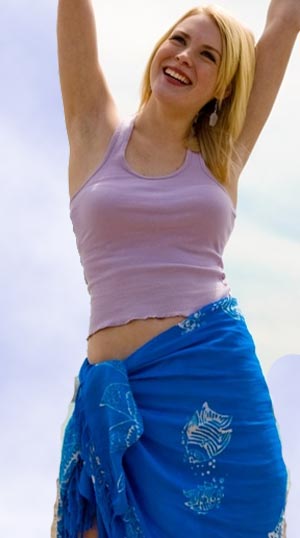Sarong

Sarong or sarung is usually a big piece of fabric that is worn around the waist by both men and women. This type of costume is popular in Southeast Asia, South Asia, many parts of Pacific islands, and parts of Africa. Sarongs can also be used as wall hangings, baby carriers, shawls, upper torso garment or as a total dress.
Sarong means ‘sheath’ in Malay and represents the lower torso garment worn by people in Malay. Traditionally sarongs are wrapped around the waist and knotted by pulling the loose ends together. Are you considering a wedding sarong for a beach wedding? Look up different ways to tie a sarong. Read more on Hawaiian sarongs and plus size sarongs.
Sarong
The fabric from which sarong is made is usually very bright in color and has elaborate designs illustrating animals and plants. It has either geometric or checkered patterns. The length of the standard sarong is about two and half feet and the width measures about a yard. At the center of the sarong just diagonal to the tapering width, a section of dashing and contrast colors or pattern measuring about one foot wide is woven or dyed into the fabric. This is known as the ‘head’ or kepala of the sarong. The tapering edges are stitched together and this gives the garment a tubular appearance.
Malay men wear sarongs that are woven in a checked pattern and women wear sarong dyed using the batik technique. Sarongs made for women are bright in color and have flowered motifs in them.
How to tie a sarong
A sarong can be worn in many styles; the most customary way of wearing a sarong is in a tubular fashion. You can never wear a sarong wrong as it can be worn the way you like to. Sarongs can be worn as a skirt, a dress, a top, a headband, a hatband, a scarf or a shawl. Follow these simple steps to fasten your sarong safe and securely on your waist.
- Wrap the sarong around your waist.
- Hold the top two corners of the sarong and form a ‘tie’ while drawing the slack ends through your fisted hands.
- You can make either a granny knot or square knot. Tie and draw together the upper and lower ends, knot the tie and draw the ends from side to side, knot once again and secure the sarong tight.
- Fluff out the tie and ensure the right side of the garment shows out and make sure the knot looks good too.
- You can tie the sarong either in the front, back, or side thus giving it three different looks.
Sarong ties
Sarong ties are designed just for the convenience of the users; the ties hold back the sarong at the designated place and also give the garment a fashionable look. Sarong ties offer the convenience of holding the sarong without the traditional bulky knot. Sarong ties are pretty easy to use - you just have to slide the ends of the sarongs into the openings of the sarong ties.
Pull the sarong fabric outwards and the sarong tie towards your hip and secure it safe. Tie the fabric and your sarong is fastened safe and secure. The most popular type of sarong ties is made from coconut shell. Sarongs made from coconut shells are available in different shapes. Sarong ties are also made from sea shells, wood, and Mother of pearl.
Hawaiian sarong
The ‘pareo’ is how sarongs are popularly referred to among the Hawaiians. The Tahitians carried their pareo into Hawaii and set in a new fashion wave. Few of the traditional Tahiti designs are used in modern day sarongs. The sarong became very popular as a beach dress in Hawaii during the 1940s. Sarongs became very popular yet again in the 1980s as popular summer attire.
Vibrant, multipurpose sarongs are fashion statements in the Hawaiian Islands and are worn by both men and women. Sarong is adorned as a skirt or as a dress and is generally fastened with the traditional coconut shell buckle. Numerous varieties of coconut shell buckles are available.
Wedding sarongs
If you plan a beach wedding, backyard wedding, boat wedding, gazebo wedding or any outdoor wedding then you can consider a wedding sarong for a wedding dress. Sarongs make for a unique and non fussy wedding dress. Wedding sarongs are available in numerous styles; you can choose a simple yet well-designed or stylish one with intricate embroidery. The most commonly available wedding sarongs in the market are:
- Casual rayon white sarong
- 2 and 3 piece Caribbean wedding Wrap Collection - 3 piece sarong skirts and strapless scarf tops.
- Bridal satin strapless bodices with tie or lace and sarong gown fashion skirt - with hand sewn pearl beads and sequins.
- Stylish sarongs in georgette with beautiful embroidery all over.
You can either make a pick from them or design one on your own. Earlier wedding sarongs were mainly white but now the choice of colors includes champagne, ivory and blush colors. Wedding sarongs are usually handmade. According to personal choice, wedding sarongs can be worn in different styles.
- Wrap the sarong around your body like a bath towel; cross the loose ends and tie it around your neck.
- Folded sarong makes a two piece matching set. To make a top, you can fold the full size sarong into three and form a knot at the center and tie it at the back. For the skirt, fold the sarong into two and tie it in the front.
- You can combine the sarong with a halter-top.
- For a smooth wrap skirt, you just have to wrap the sarong around your waist. Overlap the ends and fold it inwards, secure the sarong with sarong ties.
- Drape it around your body and secure it around your bust.
Batik sarong
Initially batik sarongs were worn by the families of aristocrats. Batik sarongs come with gorgeous and striking art forms printed on them. Batik sarongs are very common in the Southeast Asian countries. The striking colors and richness of these sarongs have made them popular among the Westerners too.
Batik sarongs look their best when worn as skirts, as a cover-up on top of a beach dress or when it is tied over a backless dress. Batik sarongs can also be used as decorative wall hangings. Batik sarongs are unique as they are completely handmade and many dedicated hours go into the making of every sarong.
Plus size sarong
Larger people need not worry any longer about exposing their unwanted flab while wearing sarongs. Just like any other plus-size clothing, plus-size sarong comes to the rescue of such people. Plus-size sarongs can help protect the skin from unwanted and excessive sun exposure.
Top of the Page: Sarong
Tags:#sarong #sarong ties #Hawaiian sarong #batik sarong #wedding sarong #plus size sarong
 Shopping Guide
Shopping Guide Frugal Shopping Tips
Shopping Bags
Rolling Bags for Shopping
Gym Bag
Women Accessories
Texting Gloves
Women's Wallet
Belt Buckles
Clutch Bags
Women Personal Care
 Clothing Shopping
Clothing Shopping Sleeping Eye Mask
Laptop Backpack
Women's Briefcase
Women's Jacket
Women's Shoes
Summer Footwear Trends
Wide Width Shoes for Women
Women's Flat Shoes
Slippers for Women
Sarong
Summer Shoes
High Heels
Bridal Shoes
Designer Handbag
Outdoor Clothing
Shibori Design Techniques
Batik Fabric
Tie Dye Fabric
Plus Size Swim Wear
Facial Steamers
Stress Relief Products
Gadgets for Women
RFID Technology - RFID Application
Residential Thin Film Solar Panels
Renewable Energy Gadgets
Pepper Spray
Lift Chair
Laptop accessory
Device GPS Tracking
Plasma Television
Polarized Sun Glasses
Home Blood Pressure Monitor
Air Purifier
Car Shopping
Pet Carrier
Brochure Holder
Lanyard
Baby Stroller
Step Pedometer
Jewelry
 Jewelry and Ornaments
Jewelry and Ornaments Coral Jewelry
Replica Watch
Expensive Engagement Rings
Vintage Jewelry
Gifts and Occasions
 Valentine Day Gift Shopping
Valentine Day Gift Shopping Mother Day Gift
Handmade Baby Gift
Gifts under $50
Unusual Gift Ideas for Women
Baby Shower Gift
Unique Housewarming Gifts
Unique Wedding Favor
Winter Wedding Ideas
Holiday Shopping
Holiday Shopping Tips
Christmas Shopping Online Trip
Christmas Decoration Idea
Christmas Gift Gadget
Corporate Christmas Gift Idea
Stocking Stuffers
Christmas Candy Recipe
Currency Conversion
Top of the Page: Sarong
Popularity Index: 102,311

